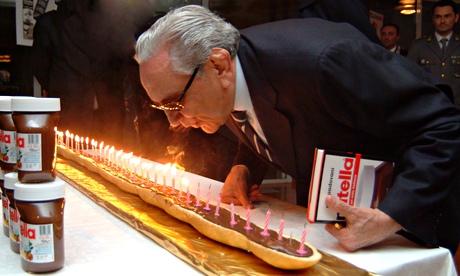
When Michele Ferrero took over his family’s confectionery firm on the death of his uncle, Giovanni, in 1957, he wrote a letter to his employees. “I pledge myself to devote all my activities and all my efforts to this company,” it said. “And I assure you that I shall only feel satisfied when I have managed, with concrete results, to guarantee you and your children a safe and tranquil future.”
Ferrero, who has died aged 89, was an entrepreneur of a kind Italy throws up from time to time, inspired more by the social doctrines of the Roman Catholic church than by any belief in the merits of the free market. Over more than half a century, he turned his family firm into a giant multinational, with a turnover in 2014 of €8.4bn (£6.2bn), and made himself Italy’s richest individual, with a personal fortune that Bloomberg last year put at $26.7bn (£17.4bn).
Yet he never deviated from the benign, paternalistic spirit of that first declaration. And he never felt satisfied: he would work all day on Sunday, or through the night, with his closest associates, experimenting and tasting to find new formulas and products. Over the years, there were many of them, including Kinder bars and eggs, Tic Tac mints and Ferrero Rocher pralines. But at the origin of his company’s success was the thick brown spread that remains at the heart of it – Nutella, a blend of chocolate, nut paste and other ingredients, the recipe for which is a secret as closely guarded as that of Coca-Cola.
Secrecy was a personal Ferrero hallmark, too. He never gave a newspaper interview, refused to accept honorary degrees and, according to a report in the daily Corriere della Sera, scrutinised prospective employees from behind a two-way mirror. Because of an eye affliction, he took to wearing dark glasses that made him seem even more remote during his rare public appearances.
Son of Pietro Ferrero and his wife, Piera (nee Cillario), Michele was born at Dogliani, south of Turin, in an area known as the Langhe. It is famous for its wines, truffles – and hazelnuts, which in the previous century had given rise to a local speciality, gianduia. Pietro, who ran the business with his brother, Giovanni, created a product based on gianduia. In 1964, Michele changed the recipe and relaunched it as Nutella. With its associations of childhood indulgence, Ferrero’s spread has since become the ultimate in branded comfort foods. Appropriately, reassurance is central to the firm’s philosophy. Ferrero is said once to have remarked that he was a socialist, adding: “But I do the socialism.”
He arranged for his employees to be collected from the villages around the company’s headquarters in the town of Alba by buses that returned them to their homes at the end of their shifts. He gave them free medical care and other welfare services, including company outings at which they sang a song in local dialect including a line of thanks to “monsu Michele” – Mr Michele. To this day Ferrero’s workers have never gone on strike.
In recent years, the firm has paid growing attention to issues of equity and sustainability in the developing countries from which it takes many of its raw materials.
Behind all this lay Ferrero’s deep attachment to principles instilled in him by his family and the Somaschi Fathers, whose school at Cherasco he attended as a boy. He visited Lourdes at least once a year, arranged for statues of the Virgin Mary to be erected in every Ferrero factory around the world and, it is claimed, took the inspiration for his Ferrero Rocher pralines from the Rocher de Massabielle, the rock grotto at Lourdes at which Mary is reputed to have made a miraculous appearance in 1858.
Ferrero’s faith was all of a piece with the habits of a man who spoke in dialect, never attended a university and harboured a lifelong suspicion of the effects of higher education. Carlo Petrini, the founder of the Slow Food movement, who comes from the nearby town of Bra, said Ferrero “embodied the profound spirit” of his homeland.
Yet – and this is something that rankled with many of his compatriots – he did not live there. He fled Italy at a time when the Red Brigades were kidnapping the members of rich families such as his, but unlike others he never returned, preferring the fiscal advantages conferred on him by tax residence in Monaco.
With his wife, Maria Franca Fissolo, whom he married in 1962, Ferrero had two sons, Pietro and Giovanni, who in 1997 became the firm’s joint chief executives. Pietro died of a heart attack in 2011. Ferrero is survived by Maria and Giovanni.
• Michele Ferrero, confectioner, born 26 April 1925; died 14 February 2015

